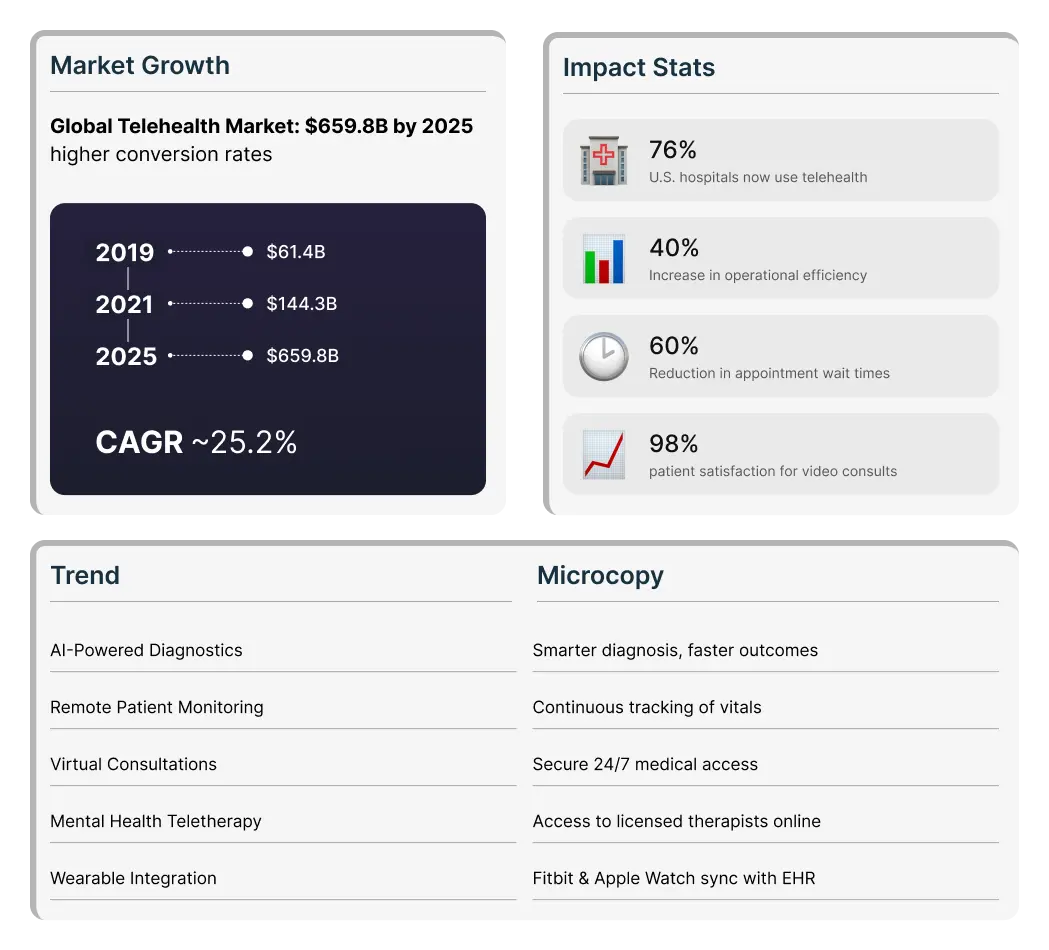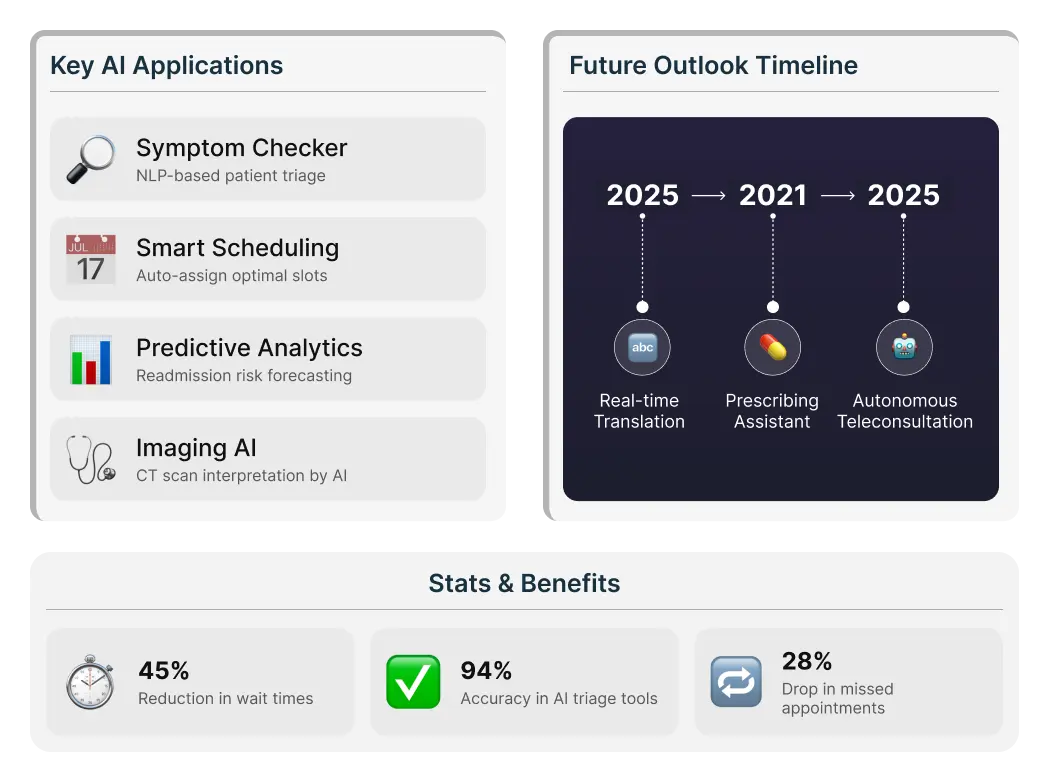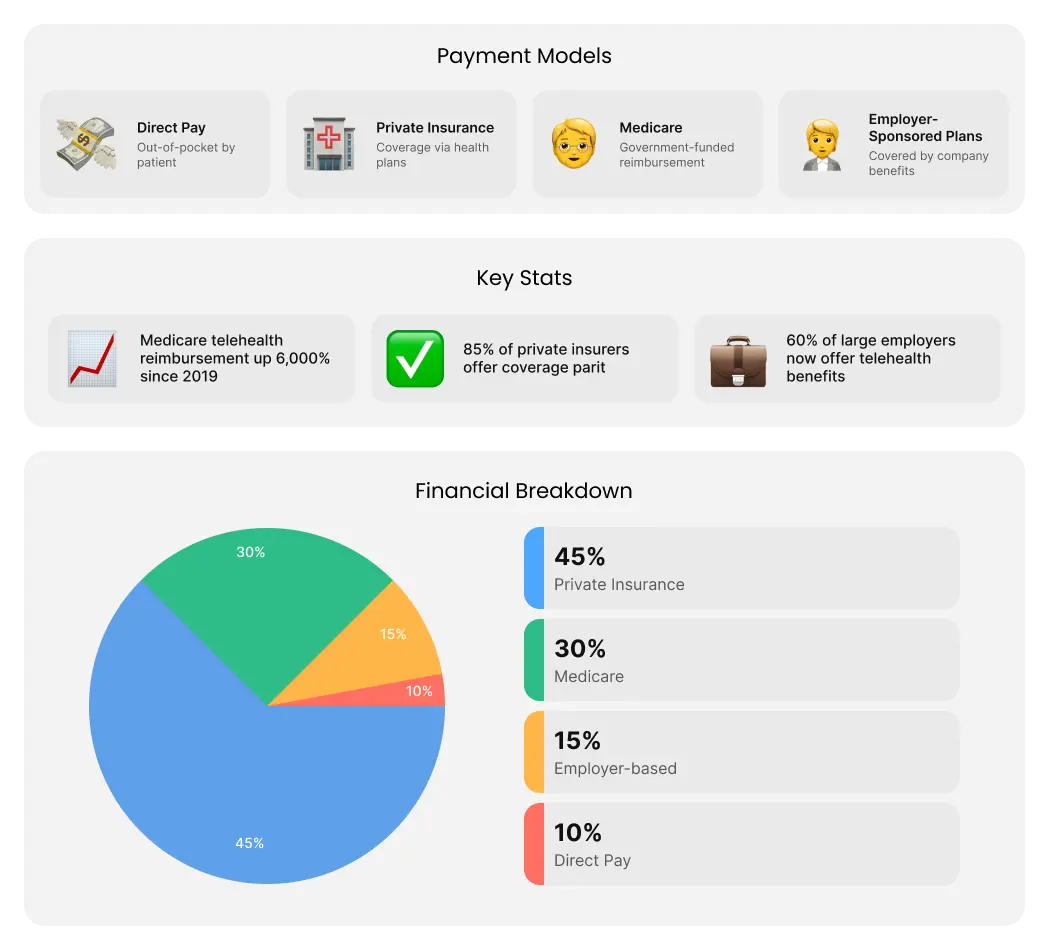 By Jophin July 9, 2025
min read
By Jophin July 9, 2025
min readTop Telehealth Trends for Healthcare Leaders
Game-Changing Telehealth Trends Transforming Healthcare
Telehealth companies globally are facing an unprecedented crisis. Provider shortages have reached critical levels, patient expectations for digital-first experiences are skyrocketing, and traditional care delivery models are crumbling under financial pressure. Meanwhile, 43% of healthcare executives admit they’re falling behind competitors who’ve already embraced digital transformation.
Hesitating to embrace telehealth is costly. Organizations sticking to outdated care models are losing millions in revenue, with patient satisfaction dropping 35% when digital options aren’t available. Every delay gives competitors an edge, capturing market share and high-value patients. That’s why forward-thinking healthcare leaders are partnering for seamless telemedicine integration, avoiding the costly mistakes that derail 60% of DIY telehealth initiatives and accelerating digital transformation.
With over 76% of hospitals now using telehealth services, understanding current telehealth trends has become the definitive competitive differentiator. As per Grand View Research, the global telehealth market is projected to reach $ 141.19 billion by 2024 and is projected to reach $ 380.33 billion by 2030 representing permanent shifts in Telehealth delivery that make digital health literacy crucial for organizational survival.
 Source: Grand View Research
Source: Grand View Research
Top Telehealth Trends for 2025: What’s Shaping the Industry
1. The Growth of AI and Automation in Telehealth
Artificial intelligence leads to transformative telehealth trends, with 87% of healthcare leaders planning to increase AI investments by 2025. Machine learning algorithms analyze patient symptoms in real-time during virtual consultations, providing evidence-based diagnostic recommendations that enhance clinical decision-making accuracy.
 AI-driven telehealth trends deliver measurable improvements:
AI-driven telehealth trends deliver measurable improvements:
- Automated patient triage systems cut wait times by up to 45%
- Intelligent diagnostic tools achieving 94% accuracy in symptom analysis
- Intelligent scheduling systems improve provider availability and patient access
- Natural language processing automating clinical documentation
- Predictive analytics identifying high-risk patients before complications
Healthcare organizations implementing AI within telehealth trends report 30% improvements in operational efficiency while maintaining superior patient care standards.
2. Remote Patient Monitoring: Key Devices and Tools
Remote patient monitoring is rapidly becoming the leading telehealth trend, with market projections estimating a $503.8 billion valuation by 2032, as stated by Global Market Insights Inc. Continuous health tracking enables proactive healthcare management, shifting from reactive treatment to preventive care approaches.
Key monitoring technologies include blood pressure monitors providing real-time cardiovascular data, continuous glucose monitors for diabetes management, wearable ECG devices detecting irregular heart rhythms, smart inhalers tracking medication adherence, and pulse oximeters measuring oxygen saturation remotely.
Patients using remote monitoring report 38% fewer hospital readmissions and 25% better medication adherence rates. Connected health ecosystems create comprehensive patient profiles, enabling personalized care plans that adapt to individual needs.
The window for competitive advantage is closing rapidly. Telemedicine leaders who delay comprehensive telehealth implementation, risk permanent market disadvantage. Discover how our proven implementation methodology has helped Fortune 500 telehealth platforms achieve 40% revenue growth through strategic telehealth app development and transformation.
3. Payment Models for Telehealth Visits: Current Trends
Payment trends for telehealth visits have evolved dramatically, with Medicare and private insurance expanding coverage to support virtual care sustainability. Current payment telehealth trends show significant progress:
- 85% of private insurance companies now provide the same coverage for telehealth as they do for in-person visits
- As per KFF Health News, Medicare telehealth reimbursement increased 6,000% since 2019
- Value-based payment models incorporating telehealth quality metrics
- Direct-pay telehealth services growing at a rapid speed annually
- Employer-sponsored health plans expanding virtual care benefits
 Insurance providers recognize telehealth’s cost-effectiveness, with virtual consultations averaging 25% lower costs than in-person visits while maintaining comparable clinical outcomes.
Insurance providers recognize telehealth’s cost-effectiveness, with virtual consultations averaging 25% lower costs than in-person visits while maintaining comparable clinical outcomes.
4. Redefining Mental Health Care Through Telehealth
Mental health care has become one of the most successful areas for telehealth, with virtual therapy sessions seeing a significant rise since 2020, driven by the need for remote support during the pandemic as highlighted in a recent study. Digital platforms are transforming the mental health landscape by breaking down access barriers and reducing the stigma often associated with seeking psychological support.
Many regions continue to face challenges in providing adequate mental health care, with millions of individuals living in underserved areas where access to qualified providers is limited. Telehealth is helping to address these gaps by enabling providers to extend care beyond geographic constraints, ensuring that individuals receive timely and effective support.
Specialized telehealth solutions in mental health include crisis intervention protocols, medication management tools, virtual group therapy, cognitive behavioral therapy (CBT) apps, and peer support networks. These digital solutions have shown impressive results, with 73% of patients reporting improved access to care and 68% demonstrating better adherence to treatment plans.
Financial Impact of Telehealth Trends
Telehealth adoption is driving major financial benefits for digital health providers, with improved revenue streams and substantial cost reductions. Financial analyses across the sector show a proven return on investment (ROI) from telehealth integration.
The financial benefits of telehealth are clear and measurable and Telehealth trends deliver measurable, immediate benefits, such as:
- 20-40% reduction in operational costs through resource optimization
- 15% increase in patient volume without facility expansion
- 65% decrease in appointment no-shows improving revenue predictability
- 30% reduction in administrative overhead through automation
- 25% improvement in provider productivity and patient throughput
Beyond financial impact, patient satisfaction is also a key driver. Telehealth aligns with consumer preferences for accessible and convenient care. Practices adopting telehealth trends see an average 23% increase in patient satisfaction, boosting retention and referrals.
Emerging Technologies Shaping Telehealth Trends
1. Unlocking New Potential with 5G-Enabled Telehealth
The rollout of 5G networks is accelerating telehealth advancements by enabling ultra-low latency communication and near-instantaneous data transmission – key elements for delivering advanced virtual care. Telehealth platforms in 5G-enabled regions gain a competitive edge by offering superior service delivery and enhancing patient experiences.
Key 5G-powered applications include:
- Real-time remote surgery guidance
- High-resolution diagnostic imaging transmission
- Instantaneous vital sign monitoring during consultations
These innovations not only enhance care quality but also enable new telehealth possibilities that were previously unattainable with slower networks.
2. Enhancing Security with Blockchain Integration in Telehealth
Blockchain technology is addressing critical security challenges within telehealth, providing a secure framework for patient data exchange and ensuring privacy compliance. By integrating blockchain, telehealth providers can offer immutable patient records, enhance trust while safeguarding sensitive health information.
Blockchain applications in telehealth include:
- Smart contracts for automated and secure insurance claims processing
- Patient identity verification to prevent fraud and ensure data integrity
- Encrypted health information exchange to ensure privacy between providers
With these innovations, blockchain is positioning itself as a cornerstone technology for secure and trustworthy telehealth services.
3. Transforming Patient Care with Virtual Reality Therapeutics
Virtual reality (VR) is revolutionizing healthcare by offering immersive, non-invasive treatments that enhance patient outcomes and provider training. Since 2020, VR applications in pain management, rehabilitation, and mental health have expanded significantly, providing scalable solutions to complex clinical challenges.
Key Therapeutic Applications of VR:
- Pain Management: VR has been shown to reduce pain perception by up to 50% in burn victims during wound care procedures. Additionally, VR-based therapies have been FDA-approved for chronic pain relief, offering a drug-free alternative to traditional pain management.
- Rehabilitation: Patients recovering from strokes or surgeries benefit from VR-based exercises that promote motor skills and cognitive function. These programs are engaging and customizable, leading to improved adherence and outcomes.
- Mental Health Treatment: VR is used in cognitive-behavioral therapy to treat conditions like PTSD, anxiety, and phobias. By simulating real-world scenarios, patients can confront and manage their fears in a controlled environment.
As VR technology continues to evolve, its integration into healthcare settings is expected to increase, offering innovative solutions to enhance patient care and provider training.
Overcoming Telehealth Implementation Challenges
1. Regulatory Compliance Navigation
Telehealth compliance in the U.S. involves adhering to complex healthcare laws, such as Health Insurance Portability and Accountability Act (HIPAA) for data security and state-specific telemedicine regulations. Interstate Medical Licensing Compacts (IMLC) help providers treat patients across state lines, simplifying licensing and expanding telehealth access.
By staying informed of these evolving regulations, telehealth providers can ensure legal compliance and build patient trust.
2. Cybersecurity Priorities
Cybersecurity represents a critical component of successful telehealth implementation. Essential security measures include end-to-end encryption, multi-factor authentication, regular security audits, and comprehensive staff training programs.
Healthcare cyberattacks occur frequently, with average costs exceeding millions per incident. Organizations must prioritize security investments to maintain patient trust and regulatory compliance.
Future Telehealth Trends: 2025-2030 Outlook
1. Personalized Medicine Integration
Precision medicine integration within telehealth trends leverages genetic data and individual health profiles to develop customized treatment protocols. Genomic analysis enables targeted therapy recommendations based on genetic profiles and medication metabolism patterns.
2. Rural Healthcare Access Expansion
Rural healthcare access through telehealth trends addresses significant disparities by connecting underserved communities with specialized services. Infrastructure development includes broadband improvements and community health worker training initiatives.
Conclusion: Strategic Telehealth Implementation
The evolution of telehealth trends represents a fundamental shift demanding immediate strategic action from Telehealth executives. Organizations proactively adopting these trends capture competitive advantages while improving patient outcomes and operational efficiency. Success requires strategic planning, technological investment, and comprehensive change management.
Telemedicine leaders must evaluate capabilities, identify priorities, and develop sustainable programs aligning with organizational goals. The future depends on embracing telehealth trends that enhance accessibility, improve quality, and reduce costs. Organizations ready to transform through innovative solutions position themselves for sustained success in an increasingly digital landscape.
The decision point is now. Securing competitive advantage through proven partnerships has helped healthcare executives unlock transformative results. Contact our team to discover how our telemedicine app development can optimize your business outcomes.
FAQs
- What are the technology trends in the telehealth industry?
The key technology trends in the telehealth industry include AI and machine learning for diagnostics, remote patient monitoring (RPM) devices, 5G for better connectivity, and blockchain for data security.
- What is telehealth and how does it work?
Telehealth refers to the use of digital technologies to provide healthcare services remotely. It involves virtual consultations, remote patient monitoring, and digital health records.
- What are the payment trends for telehealth visits?
Payment trends for telehealth visits are evolving, with reimbursement being provided by Medicare, Medicaid, and private insurers. Some healthcare providers are also moving toward subscription-based models for telehealth services.
- How can telehealth improve patient satisfaction?
Telehealth improves patient satisfaction by providing convenient access to healthcare services, reducing wait times, and allowing patients to receive care from the comfort of their homes.
- What is the future of telehealth?
The future of telehealth includes advancements in virtual reality (VR), augmented reality (AR), and personalized medicine. It will also see expanded access in rural and underserved areas, making healthcare more equitable.
Author Bio


 Facebook
Facebook Whatsapp
Whatsapp LinkedIn
LinkedIn Pinterest
Pinterest







 Start Chat
Start Chat